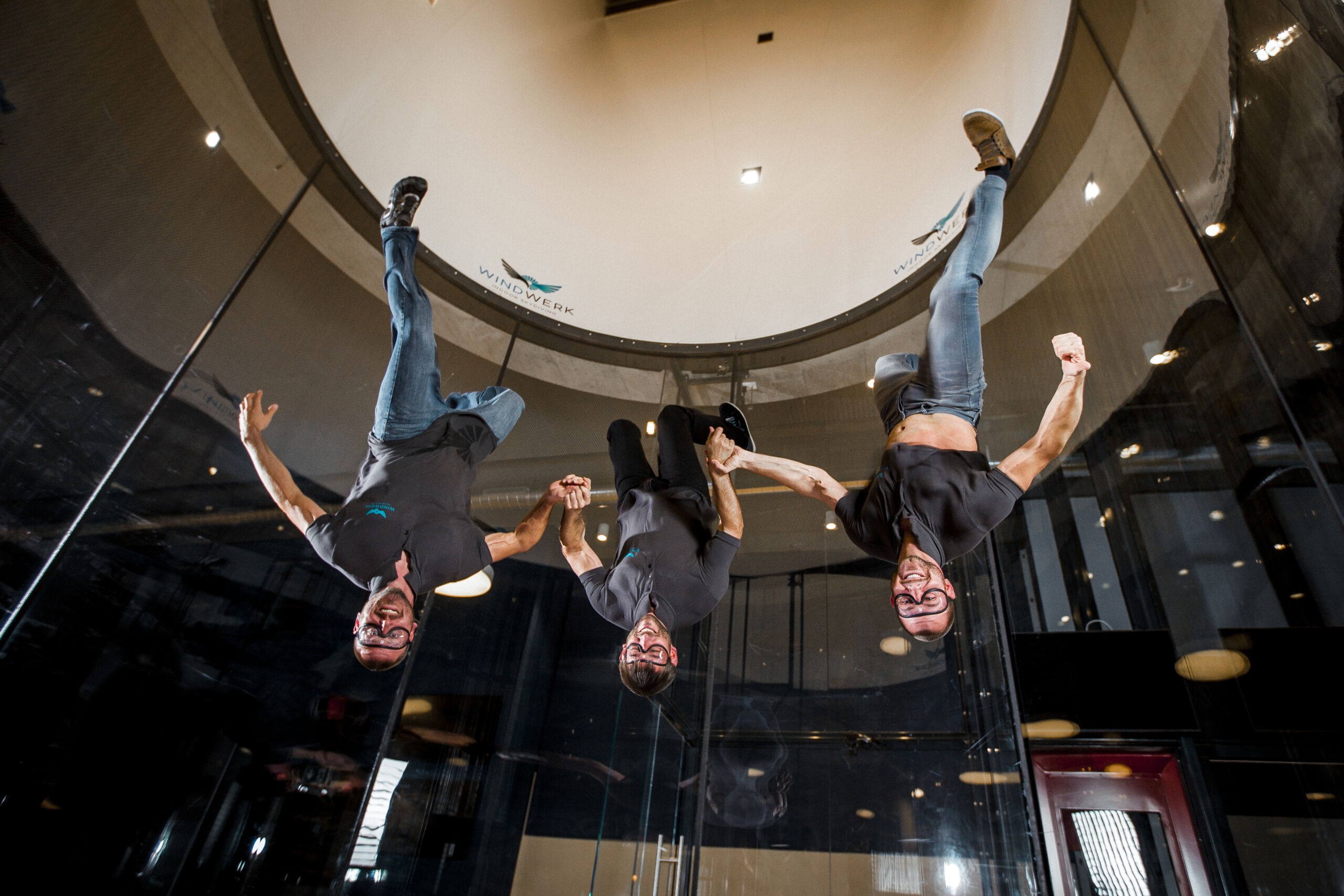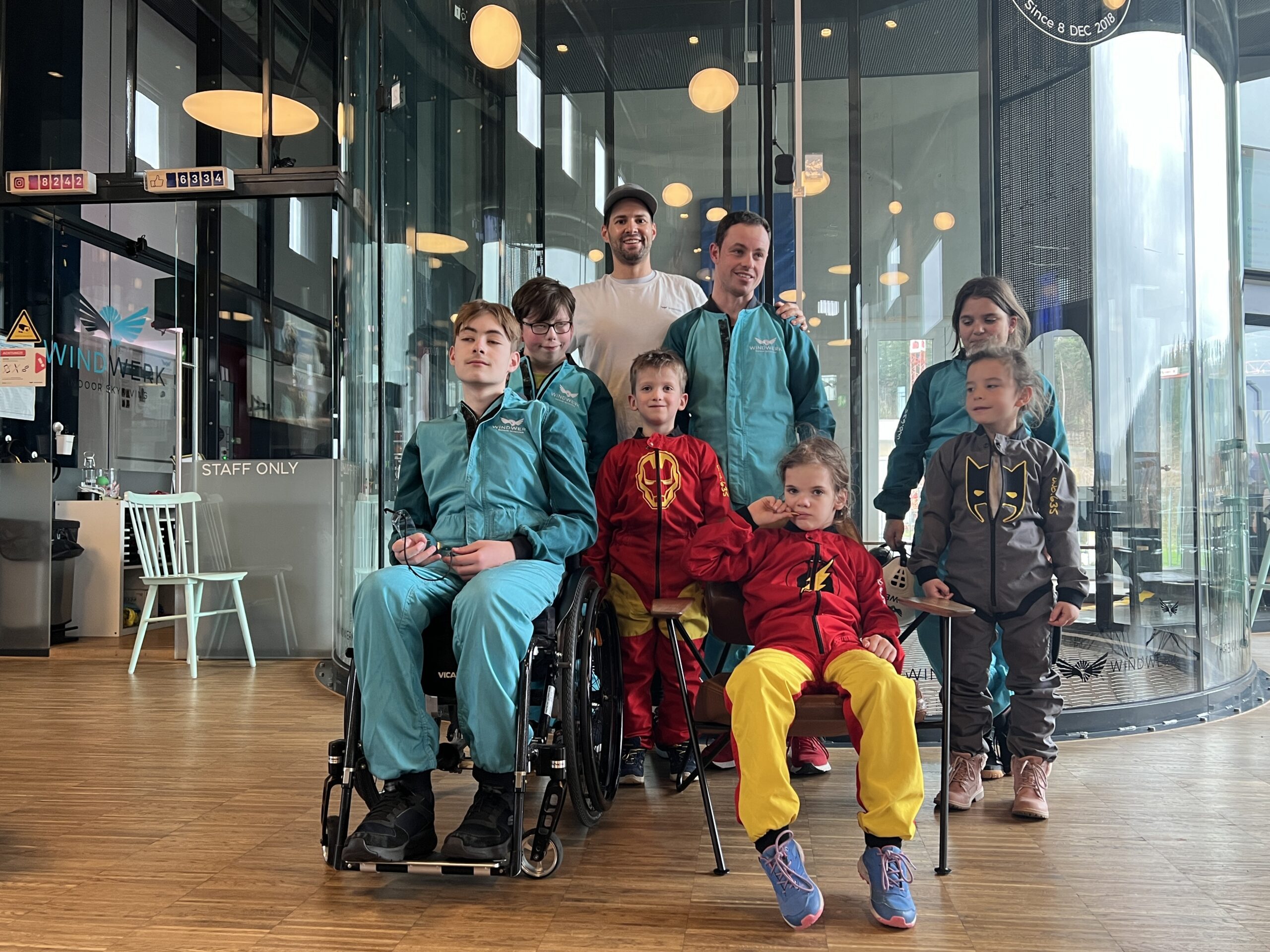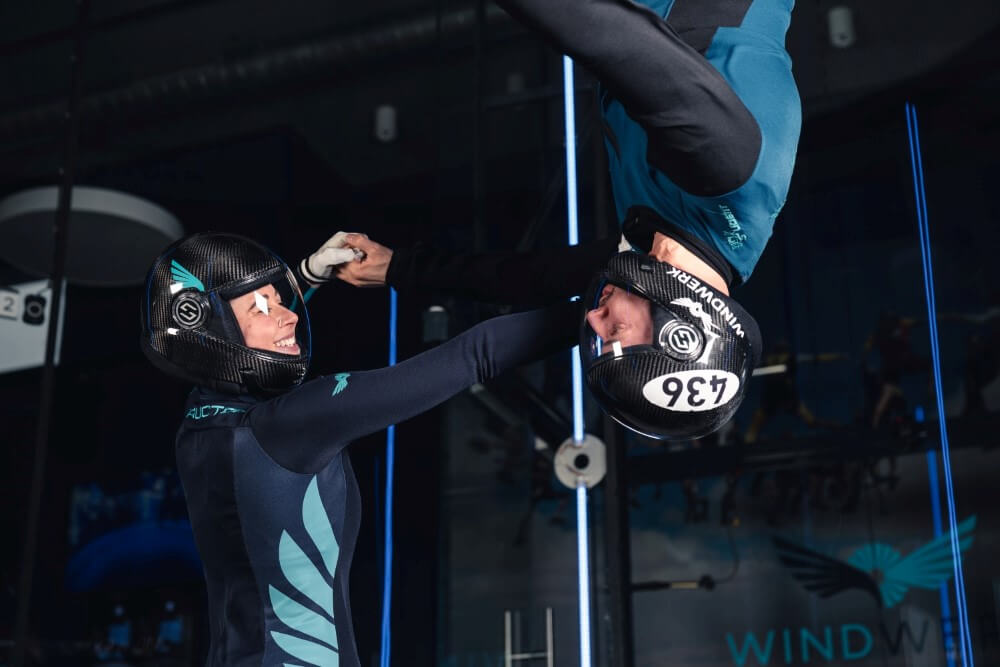Tobias Oertle, co-initiator and managing director of the Windwerk, tells you up close and personal how the wind tunnel in Winterthur came about. From the idea to the opening to the present day. It takes a lot of courage to realize such a big project. But it also shows that it is worth pursuing ideas and dreams and not giving up, even if the road is rocky. In the following, Tobias tells us what it looked like and what ups and downs were involved.

Tobias, how did the idea of creating a wind tunnel come about?
The desire to have my own wind tunnel was already set in stone with my very first flights in 2011. Back then, I dreamed of having a tunnel within my own four walls. Instead of using the stairs, I would have used the wind tunnel to change floors. 😉
All joking aside. I trained in the vertical formation skydiving discipline with my team Avalon until 2016. We actively took part in competitions. This required regular training in wind tunnels. At some point during dinner after a training day, we started to philosophize about having our own channel. In the beginning, this was pure dreaming, as we could only imagine the effort and financial resources involved.
What was your motivation for taking the project seriously?
In Zurich, bodyflying took place in Rümlang until the end of 2015. Realizing a second facility in this area was not an option for us at the time. However, when it became known that the existing facility was closing its doors and the successor project at the time fell through, our idea became firmer and discussions about it became more concrete. We knew from the outset that this would be a mammoth project for us. That was exactly what drove us. To create something that is difficult to implement.
You got the Windwerk off the ground together with two other initiators. Who did you have at your side?
Reto Welti, Andri Steinmann and I got to know each other back then – if I remember correctly – in the wind tunnel in Prague. The two of them were already very active in competitive sports before I joined the team. When their team lost a member due to health problems, they probably didn’t find anyone better than me. *laughs*
As ambitious amateur athletes, we regularly trained in the vertical formation skydiving discipline. Before we thought about the Windwerk, our focus was mainly on training. We competed in several international indoor skydiving and skydiving competitions and won the VFS discipline at the Windgames in 2015, for example. When the project started in 2016, we began to put our energy into the wind tunnel. Unfortunately, there wasn’t enough time for both, as our training sessions and the project were being pursued on a part-time basis.
With the start of construction in October 2017, it was clear that we were making our baby fly. We needed a management team. At the beginning, none of the three of us had intended to take on this position. As the project progressed, I could increasingly see myself taking over the management of the business. At the beginning of 2018, I decided to take on this challenge. Reto Welti and Andri Steinmann naturally continued to support the project, but did not want to give up their existing activities. As a result, Reto Welti is still a pilot at Edelweiss Air and Andri Steinmann is a Senior IT Consultant.
What were the first steps you took to implement the project?
We quickly realized that we had to evaluate and bring together three key components in the first phase. These were a suitable site, the right wind tunnel system and financing. This was the focus in the start-up phase.
Financing was certainly a big sticking point. How did you find investors?
Thanks to my work in the real estate industry at the time, we were able to get an institutional investor interested in the project at an early stage. Negotiations got off to a good start and we had almost secured the financing.
However, this was not to be at this point. The negotiations failed. We had already founded a public limited company and paid up 50 percent of the capital. We mainly needed the capital for studies and it was quickly used up. We were therefore at a point where we had to decide whether to inject more capital. The sum required was in the mid 6-figure range. This decision was anything but easy for us at the time and caused us one or two sleepless nights.
In the end, we decided to go for it because we were convinced and confident that we could make the project fly. However, we also knew that if we failed, we would lose a large amount of our personal savings.
As the project progressed, one thing led to another. In the 3rd quarter of 2017, with the receipt of the positive building decision, we were finally able to convince three suitable investors for the project. Gerry Künzler, Managing Director of Zani AG, who sold the plot to Windwerk AG. Bruno Bosshard, partner at BB Treuhand AG, who supported us in our search for investors, and Frank Studerus, owner of Studerus AG, who was put in touch by our system supplier by a lucky coincidence. We benefited greatly from the fact that Frank and Bruno are former skydivers and shared our passion for flying right from the start. It is ideal to be put together in such a constellation.
Which people or companies also played a key role in its realization?
Our system supplier and Daniel Ramp from the former Zani AG, a passionate skydiver, deserve special mention at this point. He found out about the project and that we were looking for a plot of land for it over lunch. He was ultimately responsible for bringing us together with the owners of the land on Ohrbühlstrasse at the time, including Gerry Künzler.
At this point, I absolutely must mention our three-initiator constellation. None of us would have dared to do this on our own. There were regular moments when at least one of us would have dropped out. In precisely these phases, it was important that at least one of us always showed optimism and got the others back on track.
Were there times when nerves were frayed or doubts arose? It is certainly difficult to reconcile all interests and opinions.
We were already working and training together in sport before the project. This was an ideal starting point. There are differences and disagreements there too. However, you have to discuss and resolve conflicts and then perform again. Our training was also cost-intensive. In this respect, too, it was already a question of using financial resources. I am convinced that this initial situation played a key role in the success of the project.
Especially at the beginning, there were constant setbacks with all three factors (land, wind tunnel system and financing). The important thing is to learn from them and move on. A new door often opens when an existing one is closed. Sometimes you just have to look a little more closely, analyze or be creative. After all, problems are there to be solved. After all, that’s the exciting thing about it ;-).
For me personally, the most intensive phase started in June 2018, when I began working 100% for Windwerk, and it lasted until the opening. During this period, the construction project, the recruitment of over 15 people, getting our accounting processes up and running, marketing with the launch campaign, the web store, the website and much more went on. Nerves were on edge from time to time and we had to work through the night.
I also remember the requirements from the building permit regarding our safety concept, which we had to present for the occupancy permit. In an overnight sprint, this X-page concept was created just in time for approval.
Were there any failures, misfortunes and mishaps that you particularly remember?
Anyone who has ever built a property can probably imagine what we were up against. What was special about our project was that we sourced the wind tunnel from foreign suppliers and there were many special interfaces and seams to solve, particularly with regard to the technology. Despite the interface paper that was initially drawn up, there were one or two discussions during the ongoing process. As we all know, the devil is in the detail. We changed a planner at a late stage because we could not agree on the concept.
The type of use was also unusual. This led to many detailed clarifications with the responsible building authorities. One of the biggest setbacks was the initial rejection of the project by the city. The reason given was that the use of the planned location did not conform to the zoning regulations. However, after some detailed clarifications, this could be argued in our favor.
Around one and a half months before the opening, we were told that certain components could not be delivered on time. This led to nervousness, as we had communicated the definitive opening date shortly beforehand. In the end, we also found a solution to this problem.
Over all, the project was a complete success. We recorded additional costs of just 2.5 percent, which was absolutely within the budgeted reserve.
How long did the project take from the idea to the opening?
The most important milestones were:
- July 2016: Foundation of Windwerk AG
- May 2017: Positive construction decision
- July 2017: Securing the financing
- October 2017: Ground-breaking ceremony and start of construction
- November 2018: First flight in the Windwerk
- December 2018: Windwerk opening ceremony
Of course, there were many more milestones. However, this would go beyond the scope of this article. It is worth mentioning that the phase between the start of planning and the start of construction was particularly challenging. We had set ourselves the goal of opening before Christmas 2018. That’s why we did without general contractor/TU submissions and instead worked with individual contracts with all companies and planners. This bought us time.
Of course, you also had to find suitable staff for the Windwerk. Indoor bodyflying instructors are probably not available on the street. How did you put the team together?
It was important to us that the people have a connection to the sport and a passion for the cause, which can also be passed on in day-to-day operations. The lack of direct competitors was a fundamental advantage for the project. However, this became more difficult when it came to recruiting staff. As a result, some of the people initially employed were from outside the industry. We could not and did not want to provide for a soft start, particularly for financial reasons. As a result, we started from 0 to 100 with the official opening and hired the majority of the workforce a week beforehand.
The team at the time did a great job as a result. Despite jumping in at the deep end, everyone did their best and our customers – at least I don’t think they felt much of the chaos and the processes in the background that were not yet in place.
How did you feel on the day of the opening?
Nervous, but also relieved. The most important milestone had been reached, but I also knew that the operational work was only just beginning and that many more challenges would follow.
Opening is one thing, then it has to continue. How did the first weeks and months go?
At the beginning, we had a lot of sports pilots in particular. But the adventure flights didn’t get off to a bad start either. We certainly benefited from the fact that bodyflying in Rümlang had already been doing educational work for 24 years. We no longer had to explain to many people what bodyflying or indoor skydiving actually is. In conversations with wind tunnels in other countries, you often hear that the initial educational work is particularly time-consuming and cost-intensive.
Then the coronavirus pandemic soon followed. How did you get through this exceptional time?
This was not an easy time. The worst phase was the start of the pandemic with the first complete lockdown. No one could estimate how bad the virus would be and how long it would all last. Fortunately, we have a good and functioning state system in Switzerland. And we are glad that we at least had a full year of operation behind us. This gave us confidence. If the situation had arisen immediately after the opening, we would probably have taken certain decisions more carefully. In the end, we reacted to the situation in the best possible way. But this phase naturally set us back.
Windwerk has been in existence for almost four years. How satisfied are you and what goals do you have for the future?
I am very satisfied with my past circumstances. I am a person who reflects a lot and at the same time focuses on and strives for future goals. I can therefore say that I don’t yet see the company at the point where I want it to be.
I have a great team and most of our divisions are on exactly the course I want them to be. I am therefore positive about the future and look forward to the challenges ahead. We are currently revising our marketing strategy and processes. We are also addressing exciting and important strategic issues within the Board of Directors.
One requirement for myself and the operational team is that we focus more strongly on strategic and, derived from this, operational goals and also address these. These are, for example:
- Revision of our energy and sustainability strategy, with procurement posing a real challenge due to the current electricity prices, which may have an impact on pricing policy in the future,
- further promote and better establish the team and, in particular, the key functions,
- Further development of our services and products,
- the one or other process optimization.
And of course there are other topics on the roadmap. However, these are not yet ready for discussion.
Looking back, would you do anything differently?
I would have liked to take more time for many things or have already implemented topics with my team. Every output requires corresponding input and resources. In the past, I have often decided against additional personnel resources. This has been particularly beneficial during lean periods caused by the pandemic.
Looking back, what are you particularly grateful for?
For the support of my family and friends. I’ve had a heavy workload since the start of the project and I work a lot. The fact that my loved ones accept and support this is not to be taken for granted. A big thank you at this point to everyone – and especially to my partner, who has my back in all matters.
What qualities should you have to realize a project of this kind?
We don’t have to be perfect. But we have to do what we do better than our competitors. That’s what drives me, and I demand the same from my team. I think that this attitude is half the battle. You also need to be persistent, eager to learn and have the desire to keep developing. Don’t bury your head in the sand when you have setbacks, but learn from them. And do better next time.
What are your personal highlights from the idea to today?
To feel that the team sticks together and enjoys its work. To see how people identify with the Windwerk, grow with it, want to develop it further on their own initiative and want to be part of the whole. Another highlight is seeing our staff make people happy every day. Seeing happy and smiling faces is simply a wonderful thing and the reward for our work.
“The greatest thing for me is that I was able to be involved in such a CHF 13 million project right from the start. An opportunity like this doesn’t come along every day. I experienced all the highs and lows and was able to play a central role, especially in the critical and complicated situations.”
– Tobias Oertle, Managing Director WINDWERK













